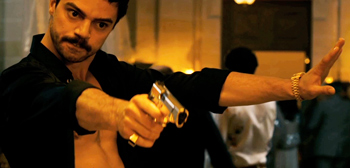|
|
|
Novembris 18., 2011
13:59
kaut kā nesimpatizē tas, ka bogomolova kungs, kurš pasniedza man seminārus imidža dizaina skolā tagad raksta slejas iekš "lilit" un stāsta visu to pašu, ko savos semināros. protams, semināros bija plašāk, semināros bija human contact moments un semināros bija pilnīgi cita aura, bet visa esence ir tepat izlikta uz lapas, un nejau tas, ka "es varēju neiet uz semināru, būtu visu pēc tam izlasījusi žurnālā", nē. kas man kremt ir, - es biju tik labās domās par viņu, bet viņš tikai atražo un atražo sevi, un nav nevienas jaunas domas. a semināri ta bija, kurā tur... 2008. gadā. vai 2009. nu, sen, karoče.
|
20:30 - : the devil's double
domājams, for our viewing pleasure, filma padarīta maigāka, nekā tā varēja būt, un tomēr, kaut kādā ne īpaši veselīgā veidā es tiešām izbaudīju visu simt deviņās minūtēs ietilpināto stāstu par sadama huseina ku-kū dēlu un viņa līdzinieku.

(dominiks kūpers.)
|
20:52

pie mums nemaz nerādīs, what the hell?
|
22:08
Veblen argued that conspicuous waste accounted for change in
fashion, but he also believed in a 'native taste' (that is, some kind of
essential good taste) to which conspicuous wastefulness was
actually abhorrent. It is abhorrent, he argued, because it is a
'psychological law' that we all 'abhor futility' - and to Veblen the
stylistic oddities of fashion were manifestly futile. He explained
fashion changes as a kind of restless attempt to get away from the
ugliness of the imposed, irrational styles, which everyone instinct-
ively did recognize to be ugly. For Veblen, then, the motor force of
fashion was a wish, forever frustrated, finally to escape the tyranny of
irrational change and perpetual ugliness.
Fashion writers have never really challenged Veblen's explana-
tions, and his analysis still dominates to this day. Yet his theory
cannot account for the form that fashion changes take. Why did the
bustle replace the crinoline, the leg of mutton sleeve the sloping
shoulder?
|
22:20 - : "adorned in dreams: fashion and modernity"
The attack on consumerism perceives our world as a seamless web of oppression; we have no autonomy at all, but are the slaves of an iron system from which there is no escape. All our pleasures become, according to this view, the narcotics of an oppressive society; and opera, pop music, thrillers and great literary 'masterpieces' should therefore logically be condemned along with fashion.
What is especially strange about Baudrillard's analysis ("Truly beautiful, definitively beautiful clothing would put an end to fashion. Fashion continually fabricates the 'beautiful' on the basis of a radical denial of beauty, by reducing beauty to the logical equivalent of ugliness. It can impose the most eccentric, dysfunctional, ridiculous traits as eminently distinctive." & "fashion is a particularly pernicious form of consumerism, since it embodies a compromise between the need to innovate and the other need to change nothing in the fundamental order. It is this that characterizes 'modern' societies. Thus it results in a game of change - old and new are not relative to contradictory needs: they are the 'cyclical' paradigm of fashion.") is that he appears to reject Marxism, while accepting this most conspiratorial of Marxist critiques of capitalism.
(mana medusmaize šovakar.)
|
|
|